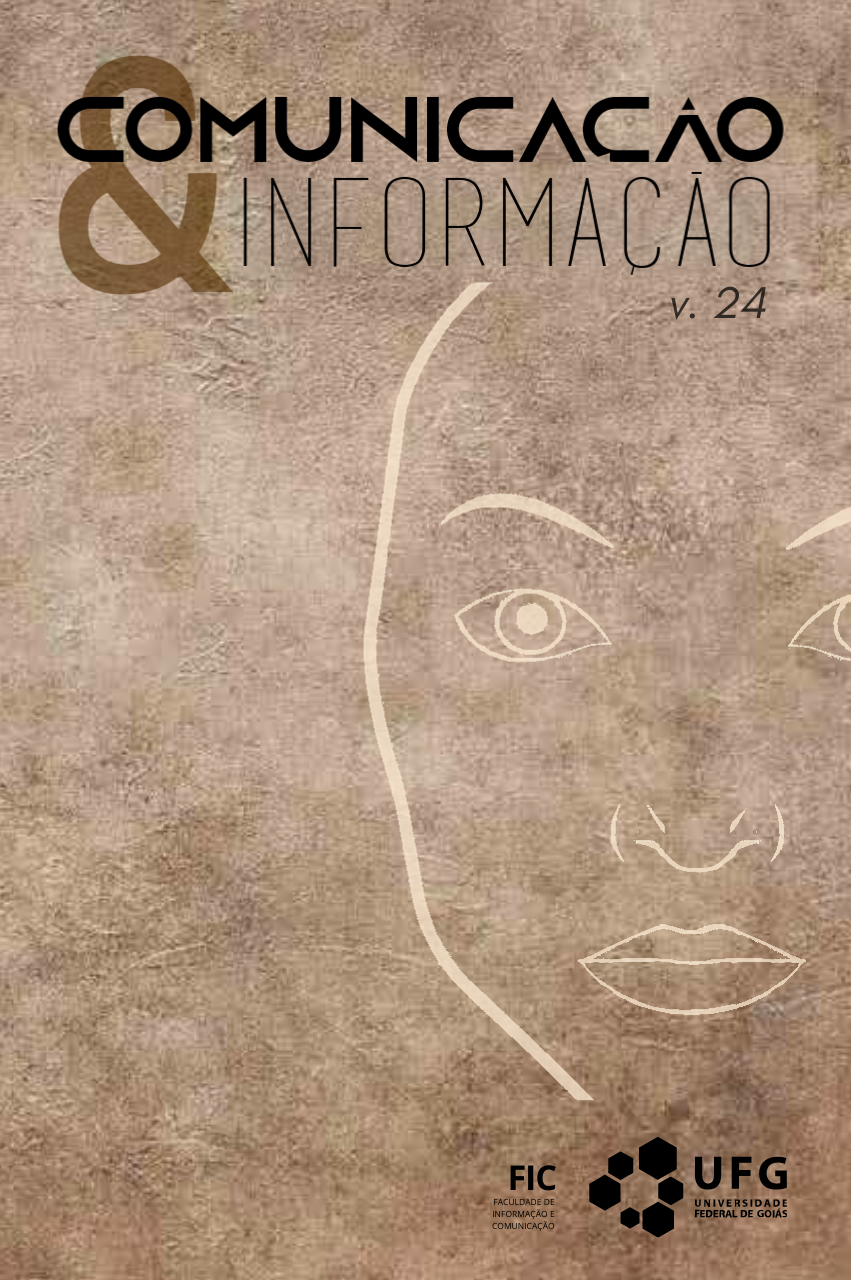O uso do corretor automático vinculado ao aplicativo Whatsapp na escrita de jovens estudantes
DOI:
https://doi.org/10.5216/ci.v24.62456Abstract
The theme of communication through social networks is analyzed in this study from the perspective of autocorrect of Brazilian Portuguese (BP) by WhatsApp application. The objective is to verify if the autocorrect and autocomplete options available in the application interfere in mastering the standard variety of portuguese by young students from Secondary and Tertiary Education. The research has an applied nature, with an exploratory and qualitative approach, involving field research with WhatsApp users contextualized in public educational institutions located in Santos (SP). The research steps are: conducting a Grammaticality Correction Test (GCT) composed of 50 sentences written in BP; filling in an electronic form structured on the Likert scale; and participation in a semi-induced conversational topic without social mediation (for the control group) and with mediation (for the experimental group). It can be concluded, after such survey and treatment of data, that the majority of the participants present generalized deviations from the standard variety in their writing, inappropriate to the phase of schooling in which they are; that there is a clear split among them, as they demonstrate contrary opinions about the need for use and the influence of the autocorrect as a facilitator in the use of the standard language; and a certain decrease in the occurrence of the same deviations when the autocorrect option was activated.
Downloads
References
ALENCAR, L. F. Técnicas em software livre para exploração de corpora do português livremente disponíveis na WWW. Veredas On-Line, Juiz de Fora, v. 2, p.134-150, 2009. Disponível em: https://www.ufjf.br/revistaveredas/files/2009/11/ARTIGO-Leonel-Figueiredo-de-Alencar.pdf . Acesso em: 28 abr. 2019.
ARAÚJO, E. M. E.; DIAS, I. S. O domínio da norma culta da língua portuguesa como determinante de inclusão/exclusão no mundo do trabalho. Revista Políticas Públicas, São Luís, v. 18, n. 1, p. 255-268, jan./jun. 2014. Disponível em: http://www.periodicoseletronicos.ufma.br/index.php/rppublica/article/download/2760/3895 Acesso em: 15 maio 2019.
BAGNO, M. Nada na língua é por acaso: ciência e senso comum na educação em língua materna. Revista Presença Pedagógica, 2006. Disponível em: http://relin.letras.ufmg.br/shlee/Bagno_2006.pdf. Acesso em: 5 maio 2019.
BOUHNIK, D.; DESHEN, M. WhatsApp goes to school: mobile instant messaging between teachers and students. Journal of Information Technology Education, v. 13, p. 217-231, 2014. Disponível em: http://www.jite.org/documents/Vol13/JITEv13ResearchP217-231Bouhnik0601.pdf. Acesso em: 28 abr. 2019.
CHURCH, K.; OLIVEIRA, R. What's up with whatsapp? Comparing mobile instant messaging behaviors with traditional SMS. Mobile HCI, Munich, p. 352-361, 2013. Disponível em: https://www.ic.unicamp.br/~oliveira/doc/MHCI2013_Whats-up-with-whatsapp.pdf. Acesso em: 20 nov. 2018.
ECO, U. Apocalípticos e integrados. São Paulo: Perspectiva, 2015.
GRÉGIS, R. A. Testes de julgamento gramatical em pesquisas de aquisição de segunda língua. 2007. 240 f. Tese (Doutorado em Letras) - Pontifícia Universidade Católica do Rio Grande do Sul, Porto Alegre, 2007.
LANIER, J. Dez argumentos para você deletar agora sua redes sociais. Rio de Janeiro: Intrínseca, 2018.
LUCCHESI, D. Introdução. In: LUCCHESI, D.; BAXTER, A.; RIBEIRO, I. (org.). O português afro-brasileiro. Salvador: EDUFBA, 2009, p. 27-37. Disponível em: http://books.scielo.org/id/p5/pdf/lucchesi-9788523208752-03.pdf. Acesso em: 28 abr. 2019.
MANJOO, F. How your cell phone’s autocorrect software works, and why it’s getting better. Slate, [S. l.], 2010. Disponível em: https://slate.com/technology/2010/07/how-your-cell-phone-s-autocorrect-software-works-and-why-it-s-getting-better.html. Acesso em: 11 maio 2019.
MCLUHAN, M. Os meios de comunicação como extensões do homem. São Paulo: Cultrix, 1964.
NUMBER of Facebook users in Brazil from 2017 to 2023. Statista.com, New York, 2019. Disponível em: https://www.statista.com/statistics/244936/number-of-facebook-users-in-brazil/. Acesso em: 13 out. 2019.
NUNES, M. G. V.; OLIVEIRA JR, O. N. O processo de desenvolvimento do revisor gramatical ReGra. Núcleo Interinstitucional de Lingüística Computacional, São Carlos, SP, 2000. Disponível em: http://www.niee.ufrgs.br/eventos/SBC/2000/pdf/semish/semi001.pdf. Acesso em: 12 ago. 2019.
PEREIRA, S. L. Processamento de linguagem natural. São Paulo: USP, 2011. Disponível em: https://www.ime.usp.br/~slago/IA-pln.pdf. Acesso em: 28 abr. 2019.
PITTOL, E.; RIGO, S. J. Certografia: um corretor ortográfico automático para português e resultados de um estudo de caso aplicado na área jurídica. Revista Brasileira de Computação Aplicada, Passo Fundo, v. 7, n. 3, p. 31-42, out. 2015. Disponível em: http://seer.upf.br/index.php/rbca/article/view/3776/3508. Acesso em: 25 jul. 2018.
RAMBE, P; CHIPUNZA, C. Using mobile devices to leverage student access to collaboratively-generated resources: a case of whatsapp instant messaging at a South African University. INTERNATIONAL CONFERENCE ON ADVANCED INFORMATION AND COMMUNICATION TECHNOLOGY FOR EDUCATION., Hainan, China. [Proceedings…]. Hainan, China: Atlantis Press, 2013. Disponível em: https://www.researchgate.net/publication/266645202_Using_mobile_devices_to_leverage_student_access_to_collaboratively-generated_resources_A_case_of_WhatsApp_instant_messaging_at_a_South_African_University. Acesso em: 29 nov. 2019.
RIEMENS, N. De directe invloed van whatsapp op schrijfvaardigheid. BA thesis, Radboud University, 2016.
SABE como funciona o corretor ortográfico do seu smartphone? Agência Trato, Rio de Janeiro, 27 dez. 2018. Disponível em: http://agenciatrato.com.br/blog/sabe-como-funciona-o-corretor-ortografico-do-seu-smartphone/. Acesso em: 13 dez. 2019.
SERRES, M. O contrato natural. Lisboa: Instituto Piaget, 1994.
SINGH, A. Facebook, WhatsApp, and Twitter: Journey towardsEducation. SOSHUM, v. 8, n.2, 2018. Disponível em: ojs.pnb.ac.id/index.php/SOSHUM/article/download/987/799/. Acesso em: 28 abr. 2019.
SOUZA, J. M.; QUIRINO, M. P. C. Reflexões sobre tecnologias móveis: construindo um ambiente de aprendizagem centrado na “geração polegar”. Revista Saberes, ano 2, n. 2, v. 1, p.90-102, jan./abr. 2015. Disponível em: https://www.faculdadeages.com.br/uniages/revista-saberes-no-2-faca-o-download/. Acesso em: 28 abr. 2019.
TEZZA, C. Material didático – um depoimento. Educar, Curitiba, n. 20, p. 35-42, 2002. Disponível em: https://www.scielo.br/j/er/a/B4J8wqGbFsHSqCf3qkF7TSG/?lang=pt&format=pdf . Acesso em 29 nov. 2019.
UEBERWASSER, S.; STARK, E. What’s up, Switzerland? A corpus-based research project in a multilingual country. Linguistik Online, v. 84, n. 5, p.105-126, 2017. Disponível em: https://bop.unibe.ch/linguistik-online/article/view/3849/5833. Acesso em: 10 ago. 2019.
VERHEIJEN, L.; SPOOREN, W. The impact of whatsapp on dutch youths’ school writing. CONFERENCE ON CMC AND SOCIAL MEDIA CORPORA FOR THE HUMANITIES, 5., Italy. [Proceedings…]. Bolzano, Italy: Eurac Research, 2017. P. 6-10. Disponível em: https://repository.ubn.ru.nl/bitstream/handle/2066/177272/177272.pdf. Acesso em: 10 jul. 2019.
VITÓRIA, M. I. C.; CHRISTOFOLI, M. C. P. A escrita no ensino superior. Educação Santa Maria, v. 38, n. 1, p. 41-54, jan./abr. 2013. Disponível em:
http://repositorio.pucrs.br/dspace/bitstream/10923/8741/2/A_escrita_no_Ensino_Superior.pdf. Acesso em 29 nov. 2019.
WEISSHEIMER, J.; CALDAS, V.; MARQUES,F. Using Whatsapp to develop L2 oral production. Revista Leitura, v. 1, nº 60, Maceió, p. 21-38, Jan./Jun. 2018. Disponível em: https://www.seer.ufal.br/index.php/revistaleitura/article/view/4208. Acesso em 28 abr. 2019.
Downloads
Published
How to Cite
Issue
Section
License
Os autores dos trabalhos publicados na revista Comunicação e Informação retêm os direitos autorais sem restrições e concedem à revista o direito de primeira publicação, com o trabalho simultâneo licenciado sob a Licença Creative Commons Atribuição-NãoComercial que permite o compartilhamento do trabalho para fins não comerciais com reconhecimento da autoria e o privilégio de publicação primeiramente por esta revista. Caso o texto venha a ser publicado posteriormente em outro veículo, solicita-se aos autores informar que o mesmo foi originalmente publicado como artigo na revista Perspectiva, bem como citar as referências bibliográficas completas dessa publicação.
Os direitos autorais dos artigos pertencem aos autores e o conteúdo dos artigos assinados é de responsabilidade exclusiva dos autores.
A revista se reserva o direito de efetuar, nos originais, alterações de ordem normativa, ortográfica e gramatical, com o intuito de manter o padrão culto da língua, respeitando, porém, o estilo dos autores.
A revista também se reserva o direito de traduzir o artigo, no todo ou em parte, para o inglês ou para o português, dependendo do idioma em que o artigo tenha sido escrito originalmente.



